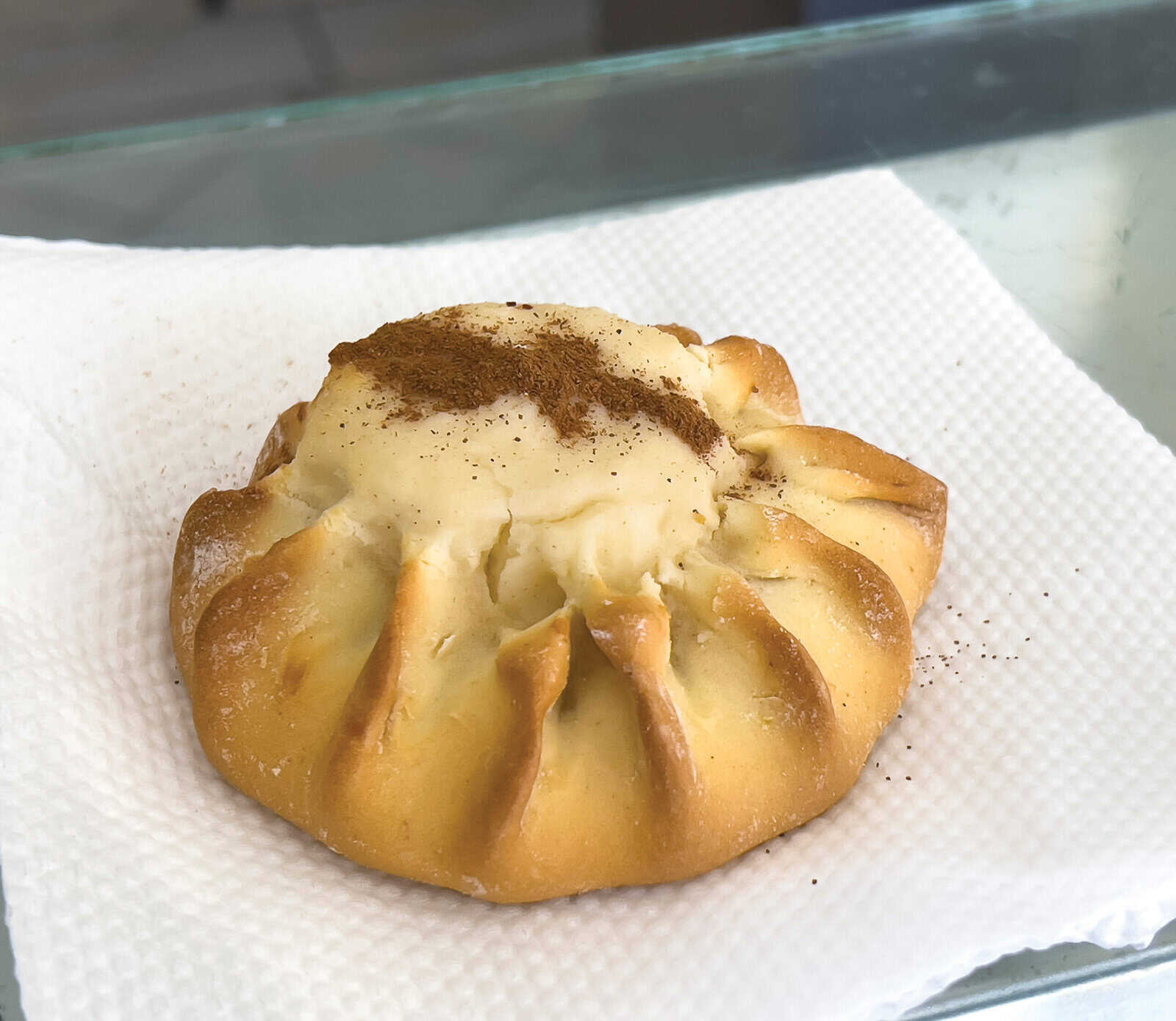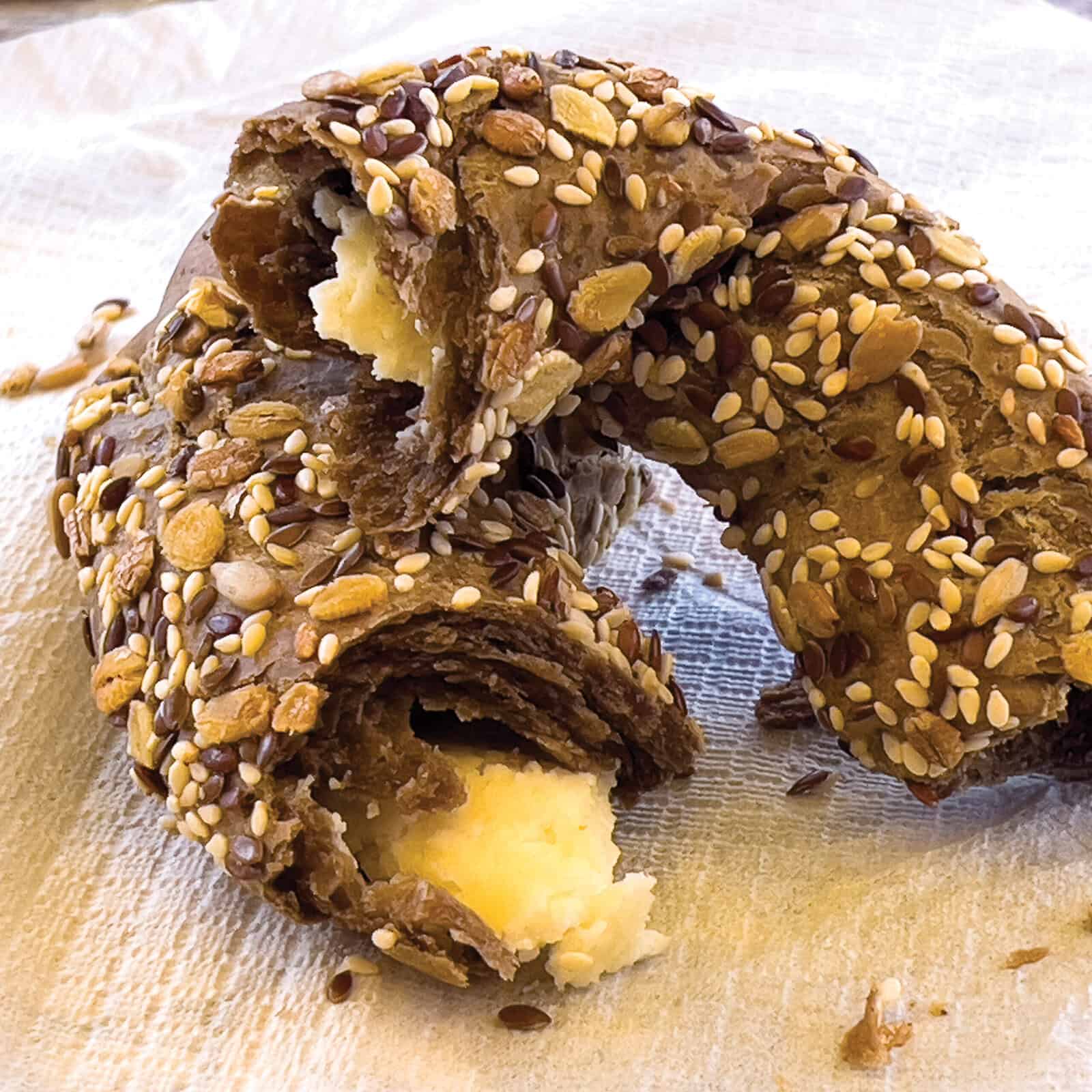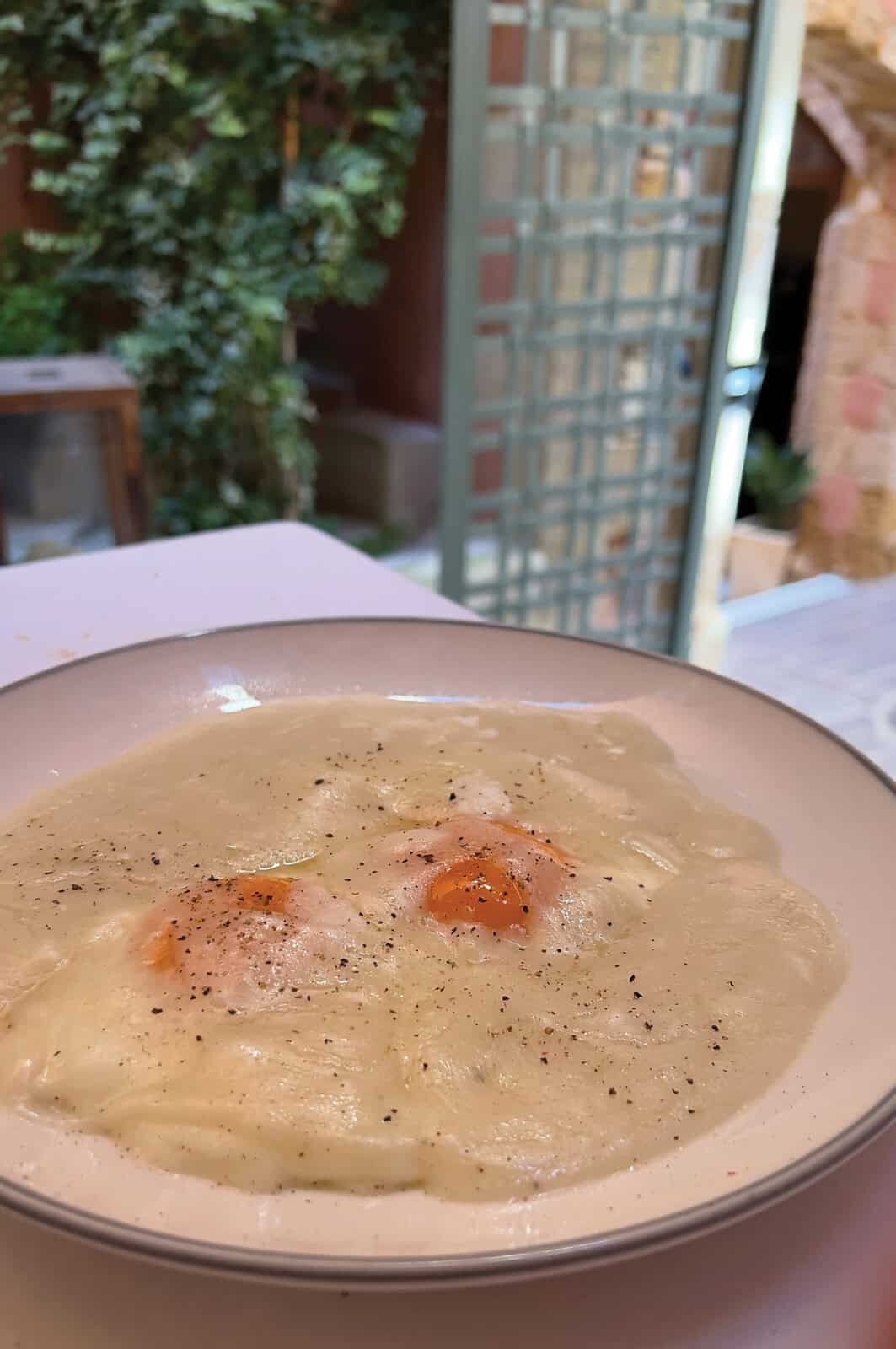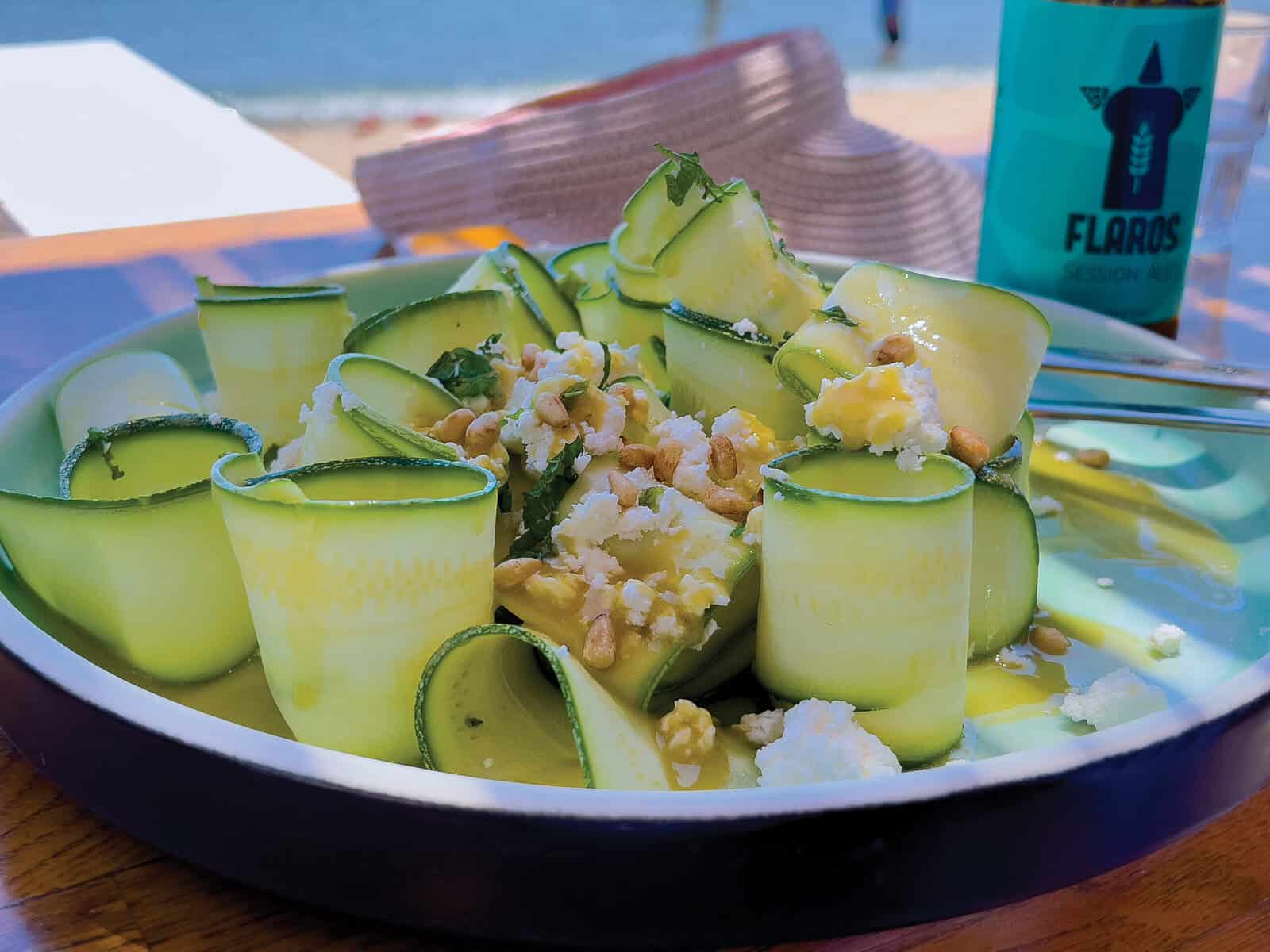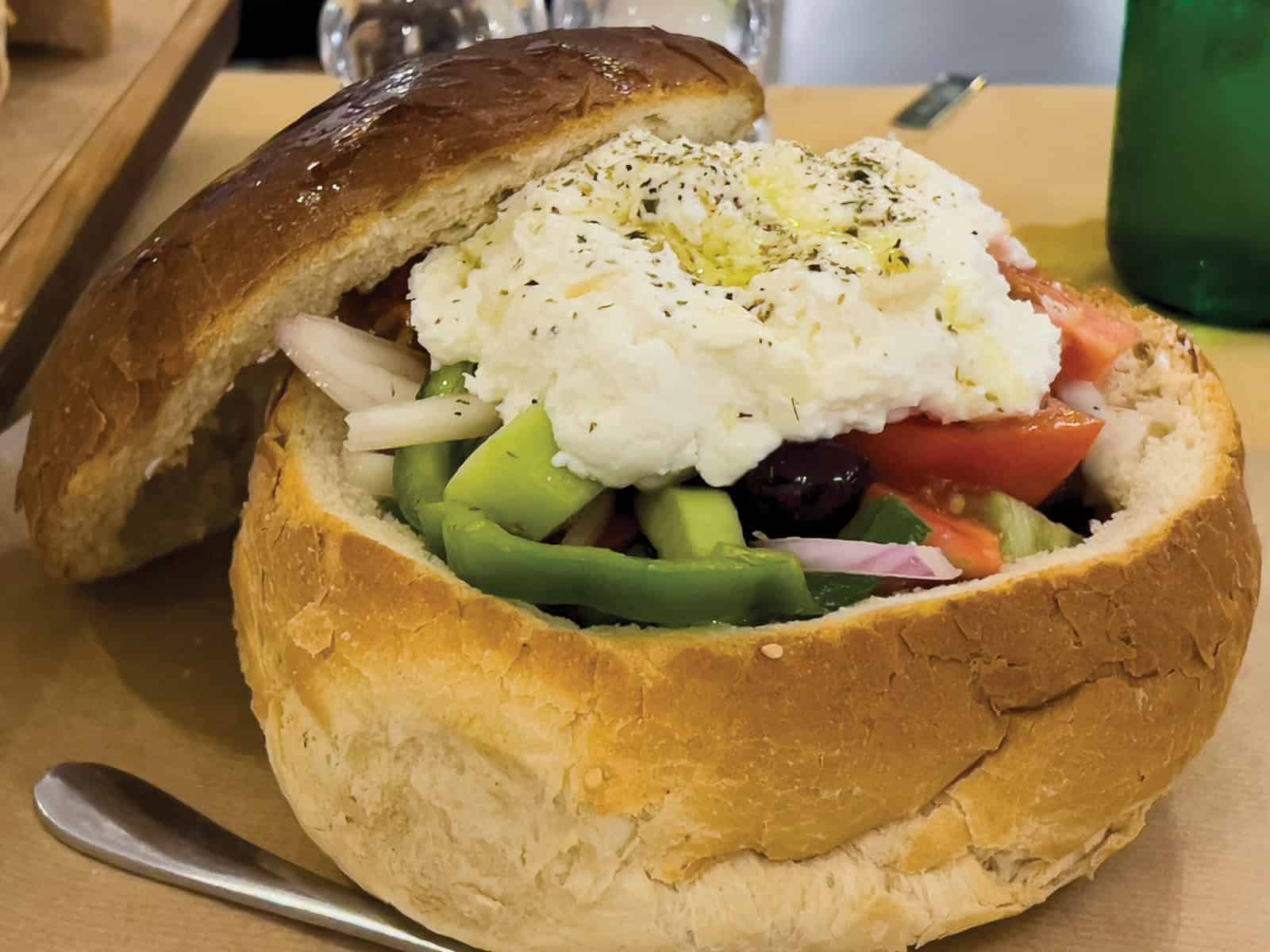Going to Greece? Don’t miss these cheesy dishes.
On vacation in Greece last spring, I figured I would consume more than a few Greek salads. I had to feed my Feta addiction, after all.
What surprised me was that most of those lovely, crunchy Greek salads I devoured didn’t include Feta at all. On the three islands I visited—Crete, Naxos, and Sifnos—Feta had a competitor.
I’ve visited Greece multiple times, but this trip held so many cheesy surprises. I tasted traditional recipes I had only encountered in books and superb modern dishes that demonstrated how chefs are updating ancient foodways.
The highlight reel from my three-week immersion ranges from rustic to refined—from the fresh, fluffy sheep’s milk cheese sampled on a disposable spoon at a Cretan farmers’ market to the elegant cooking at Avli in Rethymno.
But if forced to choose, I would put these 10 Greek island dishes on every cheese lover’s list:
1) Bougatsa
Crete’s famous bougatsa reaches its apex at Bougatsa Iordanis in Chania. My husband, Doug, and I sampled this beloved pastry elsewhere, but Iordanis’s version outclassed them all—a warm pocket of flaky pastry that crackled like glass and encased tangy, custard-like mizithra cheese. Come for a mid-morning snack with iced espresso and watch the master baker stretch his dough into sheets as thin as cellophane. Staffers slice the puffy packages into bite-size morsels and dust them with sugar. Ground cinnamon is optional.
2) Htipiti
If you’re visiting the ancient Minoan ruins at Knossos on Crete, time your visit for lunch at Apiri Greek Eatery in nearby Heraklion. I was totally charmed by this casual, energetic restaurant with its open kitchen and youthful vibe. The spicy Feta cream struck me as a deconstructed htipiti, a classic Greek dip made from Feta blended with roasted sweet and hot peppers. At Apiri, the diner does the mixing. A plate of lightly whipped Feta is topped with chopped sweet peppers, scallions, rivulets of good olive oil, and hot red peppers, all ready to slather on the restaurant’s chewy bread.
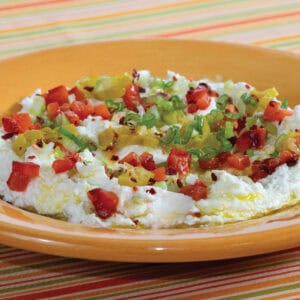
Whipped Feta Spread with Roasted Red Peppers and Scallions
Ingredients
- 16 oz Greek Feta room temperature
- 1 small clove garlic thinly sliced
- 1.5 to 2 tbsp extra virgin olive oil plus more for drizzling
- ½ red bell pepper roasted, peeled, and stem and seeds removed
- 2 scallions thinly sliced
- 2-3 pickled peperoncini sliced into rings
- Ground medium-hot red pepper, such as Maraş to taste
Instructions
- Add Feta, garlic, and olive oil to a food processor and blend until smooth, adding more oil as needed. If the mixture is too stiff, add 1–2 tablespoons of Feta brine along with the oil until creamy. Spread whipped Feta on a plate with a spatula.
- Dice the red bell pepper. Scatter over the whipped Feta. Top with scallions, peperoncini, and crushed red pepper. Drizzle with extra virgin olive oil.
3) Dakos
Greeks never drink alcohol without something to eat—a wise practice—so I shouldn’t have been surprised when Litsa Paraskevaki brought Doug and me all the fixings for do-it-yourself dakos after we ordered cocktails at Zepos Restaurant, her popular waterfront restaurant in Chania. Thick barley rusks, chopped ripe tomatoes, glistening kalamata olives, moist sheep’s milk mizithra—not unlike fresh whole-milk ricotta—and lots of extra virgin olive oil are the elements of Crete’s most beloved appetizer. Spoon the tomatoes on first so their juices soften the rusks, then top with cheese and peppery olive oil.
4) Lihnarakia
We skipped our hotel breakfast one morning in Chania and set off for two bakeries highly recommended by locals. At Mitraki Kaiti Bakery, we ate warm lihnarakia (also called kalitsounia), a tender, crumbly pastry that goes into my cookie Hall of Fame. The pleated exterior melts in your mouth like shortbread; the dreamy filling is sweetened, vanilla-scented, and cinnamon-dusted anthotyro, a fresh whey cheese from a blend of goat’s and sheep’s milk.
5) Koulouri ne Anthotyro
Just a block away on the same street is the wood-fired oven bakery of Eleni and Anna Stamataki. We ordered iced espresso and sat outside on a shaded terrace to savor our haul. My favorite was the ring-shaped koulouri ne anthotyro, a sort of whole-grain “everything bagel,” its exterior crusted with sesame seeds, flax seeds, and oat flakes, with a surprise inside: luscious, sweet anthotyro filling. I would start every day with one of these if I could.
6) Mizithra with Honey
Too simple to call it a dish, but so good: mizithra with honey. The mizithra we get in the US is older, drier, and often “sheepy.” We bought a slice from a preteen cheesemonger, who, I think, might have been helping out his grandmother, at Xatheria in Chania and enjoyed it for breakfast at our hotel with Cretan honey.
7) Staka
Before we left Chania, I told Paraskevaki that I was eager to taste staka, a uniquely Cretan specialty. The best explanation I’ve found for how it’s made is on Tony Kavalieros’ YouTube channel: he bills himself as the “Greek Chef—US.” On a commercial level, sheep’s milk (or sometimes goat’s milk) is centrifuged to separate the cream. The cream is salted and left to sour, then it’s brought to a boil with flour and stirred continuously until it separates. The clear, golden liquid is clarified butter. The remainder is staka, an ultra-rich concoction with the supple texture of pudding. Cretans eat warm staka for breakfast with eggs broken into it. Paraskevaki, whose family owns the hotel where we were staying, arranged for me to try it one morning. Imagine Cream of Wheat mixed with béchamel and you’ll be close. It’s probably not for everyone, but I loved it.
8) Cretan Meat Pie
A scenic half-hour drive from Chania into the mountains brought us to Ntounias, a highly regarded rural taverna where much of the cooking is done in clay pots over a wood fire. Our meal was outstanding and overabundant, but the dish I could not leave alone was the Cretan meat pie: shredded lamb, mizithra, and dried mint encased in sturdy yet flaky pastry. Maybe you had to be there to consider it beautiful—it’s sloppy, like lasagna—but what a soul-stirring dish. I longed to have a Greek granny who could teach me how to make it.
9) Zucchini Carpaccio
On the island of Sifnos in the Cyclades, we ate superbly—not surprisingly, given its reputation as a foodie enclave. At Omega3, an upscale seafood shack on Platis Gialos beach, we ate impeccable ceviche, but the dish that remains fixed in my memory is the zucchini carpaccio. With the vegetable shaved lengthwise, coiled, and dressed with crumbled Feta, pine nuts, mint, lemon, and olive oil, it’s a fabulous summer meal, even without the sea view.
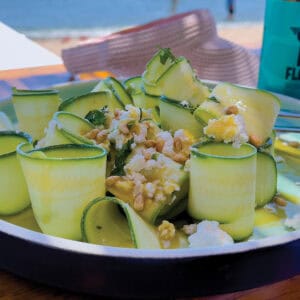
Zucchini Carpaccio with Feta, Pine Nuts, and Mint
Ingredients
- 1 lbs small zucchini ends removed
- 1/2 tsp kosher or sea salt plus more to taste
- 3 tbsp extra virgin olive oil
- 2 tbsp fresh lemon juice
- 1 small clove garlic grated or very finely minced
- 2 oz Greek Feta
- 2 tbsp toasted pine nuts
- 24 small fresh mint leaves
Instructions
- Shave zucchini lengthwise into thin slices using a vegetable peeler or v-slicer. Discard the slices that are mostly skin.
- Season zucchini with salt, place a rack, and set aside until slices are pliable enough to roll without breaking, about 10 to 15 minutes.
- Whisk olive oil, lemon juice, garlic, and salt to taste in a small bowl.
- Pat the zucchini dry with paper towels, then, loosely coil each slice into a cylinder, like a jelly roll, and stand them upright on a plate. Drizzle with the dressing. (You may not use it all.)
- Crumble Feta and scatter pine nuts on top. Garnish with torn mint leaves.
10) Salads Topped with Mizithra
Even the Greek salads were a revelation. At home, I always make them with crumbled Feta. On Crete, Naxos, and Sifnos, restaurants often offer a choice between a slab of Feta (always a slab, never crumbled) or plump spoonfuls of soft mizithra on top. I never once chose Feta. I can hardly describe the mouthfeel of fresh mizithra except by saying what it’s not—not as dense as fresh chèvre, not as milky as ricotta, just moist, tender, lightly salted curds that taste only hours old. At Apostolis, a taverna on Naxos, the salad was served in a hollowed-out round loaf of bread—my idea of the perfect meal.





